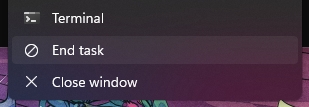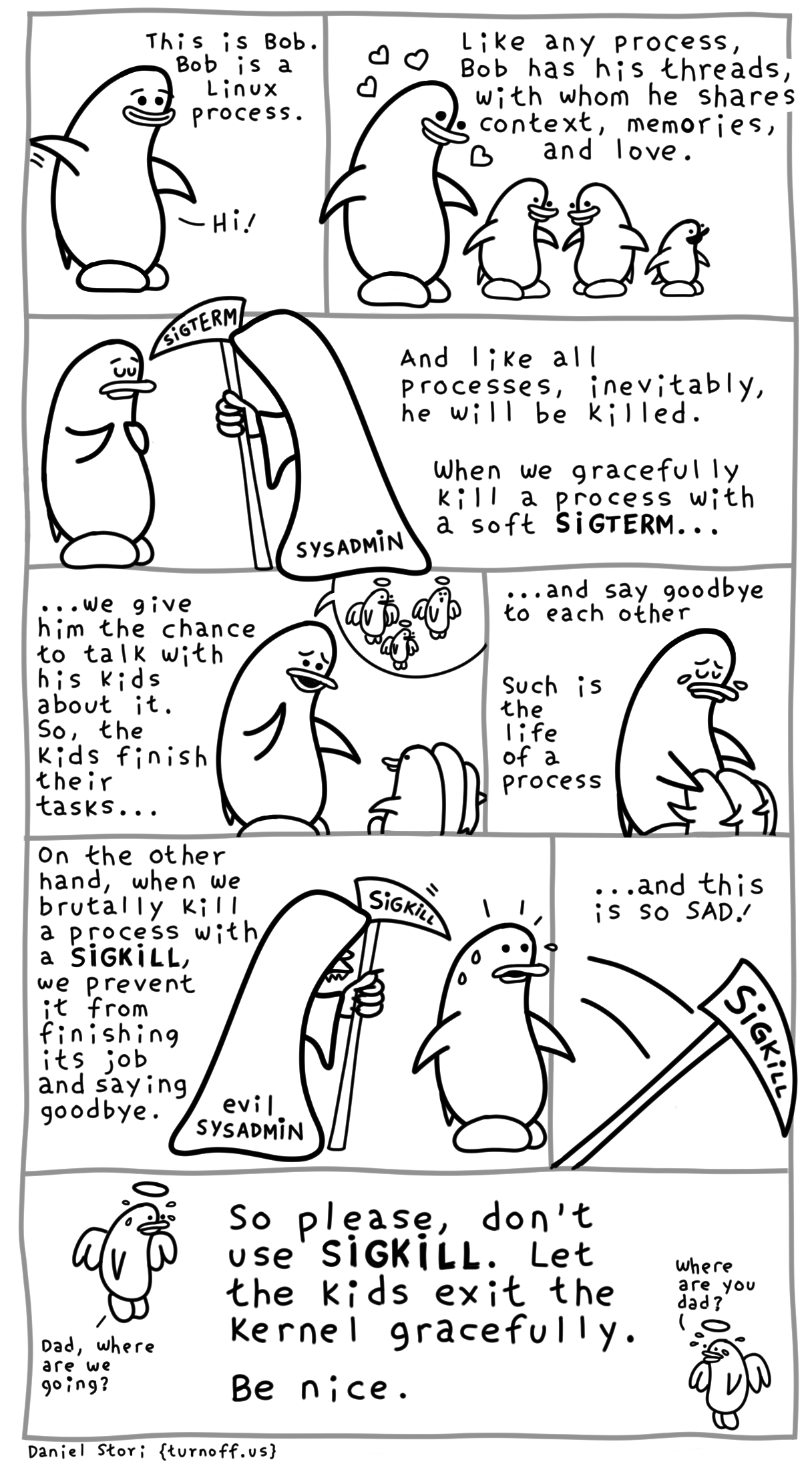Yes yes, I REALLY want to terminate that process and I am very sure about it too, ty.
both OS ask a process to end nicely? Then force closing in windows is with task manager or kill -9 in linux
I feel like I’ve had the opposite experience in the gui (maybe a KDE issue?) closing gui windows frequently lock up, and I find I frequently have to drop to the command line in order to properly kill some programs
That’s because the end proces of the GUI sends a sigint, which does jack shit if the program hangs, you only archieve for a higher parent process to obtain it until it can off itself gracefully. You need to right click the process and send a sigkill signal to emulate the command line.
That’s how the task manager does it.
There’s third party alternatives that do it like Linux does it
SuperF4 was my savior when I tried playing modded FalloutNV.
Doesn’t taskkill /force also do so for the most part? Except maybe a system protected service or something. Haven’t tried it on those.
yes, but you need to make sure you type the EXEs name in correctly instead of just clicking on it and killing it that way
Is there some Linux equivalent to “ctrl + alt + del?” I get that killing a process from the terminal is preferred, but one of the few things I like about windows is if the GUI freezes up, I can pretty much always kill the process by pressing ctrl+alt+del and finding it in task manager. Using Linux if I don’t already have the terminal open there are plenty of times I’m just force restarting the computer because I don’t know what else to do.
Try ctrl+shift+ESC And remember, there are customizable hotkeys, just explore the settings
I’ve heard those quick keys a thousand times but my brain has determined that it is not necessary information for me to retain.
Do you have enough swap allocated to your linux machine? I found that my GUI froze frequently due to not having enough of it when the computer was under heavy load.
most distros have something, yeah, generally called [something] monitor
Ctrl+alt+F1/F2/F3 etc.
It lets you switch to another terminal session, where you can use something like top/htop for a commandline equivalent to task manager.That’s what I don’t get about what they said above. If the Windows desktop freezes up, Task Manager won’t open either (happened to me quite some times over the years - less so since they moved to the NT kernel though). What you mentioned always works short of kernel panic.
I’d say it’s been over a decade since I’ve had an issue where windows task manager didn’t work. Maybe I’m not using exciting enough programs.
It definitely creeps up every once in a while on my Windows computer. It’s really not a common occurrence and only happens when I’m doing something that’s not recommended.
Actually no, it’s just that the programs on Linux usually accept SIGINT, SIGTERM, etc pretty gracefully. Some are even smart enough to handle it on a thread hang. SIGKILL is last resort.
Lots of Windows applications like to ignore the close request because Windows doesn’t have signals and instead you can only pass a window name to request exit which is the same as clicking the close button.
So any hung software won’t respond and you have to terminate it.
TerminateProcess() is pretty reliable, but it doesn’t form part of the C signals stack on Windows like kill -9. So for instance, if you’re doing process control on Python, you need to use a special Windows-only API to access TerminateProcess().
Never used kill -9. What’s the difference between that and taskkill. I usually used taskkill /pid processiwanttokill.exe /f
Kill -9 is a command on Unix and Linux to send signal 9 (SIGKILL) to a process. That’s the version of kill that is the most reliable and has immediate effect.
Taskkill is a Windows command line program. I believe that taskkill /f uses the TerminateProcess() API. This is more forceful than the End Task button on the Task Manager. There is a different End Process button on the Task Manager that does use TerminateProcess().
Is the 9 pertaining to permissions like chmod uses them? I’ll have to look it up sometime. Been awhile since I’ve ever actually needed to force quit something in a Linux os
No, it’s just the number of a specific signal.
Thanks for that, I’ll have a ganter. Need to spin up a new VM soon and figure out a new distro to play with. Been slacking on exploring new things. Mostly only played with Yellow dog (small enough to dual boot on a PS3 with 512mb of ram back in the day), Ubuntu, Debian for other things. Likely will look for something that will work well for a media server.
Have fun exploring! I just have a simple Raspberry Pi at home with a few services, after working with this stuff all the time I rarely feel like tinkering at home :D
 Enters the chat
Enters the chatmainly wrong, by default kill send a SIGTERM, you can try SIGINT or SIGQUIT too, and in the end SIGKILL of course. Same in windows there is different way
I always go straight for the SIGKILL

Every time you SIGKILL, a poorly-drawn penguin dies!
Some software: fork()
Me: Welcome to the process gauntlet loser, better not hang for a millisecond or you are dead and gone.
How the OOM Killer asks a process to terminate:
indiscriminate spraying
btw funny story since many comments mention NFS/CIFS:
I have a share mounted at /smb and the server sometimes just dies so when I want to unmount it I run umount /smb but my shell (zsh) hangs after typing umount /sm and the b doesn’t even show
I guess zsh does a kind of stat() on everything you type but bash came to save the day
I don’t know if clean ZSH does it, but if you have the zsh-syntax-highlighting plugin, it tests if the path you’re typing exists every time you edit the line.
This is entirely wrong
Lol yes oh so wrong.
Wait until you find out about taskill /F /IM explore.exe
“Userid 1000 will shut down in 2 minutes”
Or whatever it says
I haven’t seen that in a while. When you see that it means either that the service didn’t handle the terminate signal correctly or that is is busy doing something. (Sometimes both)
I was just using it as an example against the 2nd image
deleted by creator
Typing “kill -9” into a terminal is the equivalent to breaking out the acetylene torch when a nut won’t budge
Can’t be tight if it’s liquid
It even kills threads currently executing a system call! The brutality!
Never even returned to userspace…
My problem with Windows is that when I want to eject a USB drive, Windows refuses to do so, refuses to tell me what program is apparently still using the drive, and certainly refuses to kill that program. I am removing the drive. I can’t just not remove it!
Okay, yes. This fucking sucks and it happens all the time on Windows.
At that point, you need to live dangerously and just yank it.
I’ve found that in those cases its usually explorer that’s the culprit. Just having the removable drive open in explorer is enough to keep windows from being able to unmount the drive.
The worst part is that with Quick Removal it’s pretty much always safe to just remove it











